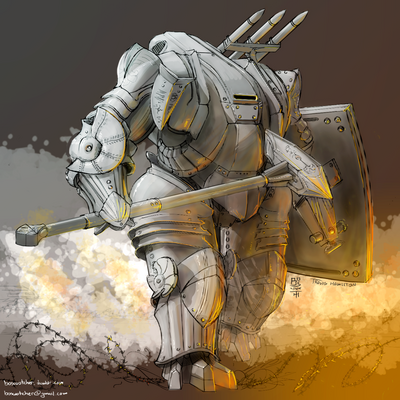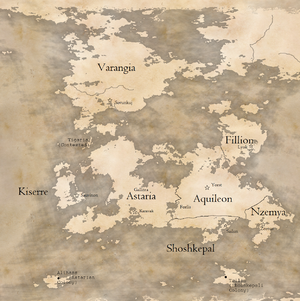Trenchbreaker

|
This article has been flagged for deletion. Comment on the article's talk page. Reminder: Do NOT blank pages when flagging them for deletion. Reason: Original author has received perpetual harassment from the /tg/ community and wants this page deleted as part of severing contact |

Trenchbreaker is a pet project of a wargame, focusing on fast and brutal trench assaults and featuring mecha of various designs, such as the one seen at right, the Astarian Model 181 "Vanguard" equipped with the "Guardian" Rig. Trenchbreaker features simultaneous turns and a damage system based on grinding your enemy's capabilities away until his mecha collapses under him, rather than whittling away at arbitrary health points until it suffers a critical existence failure. It's also notable for its brutality; "Infantry Death Simulator 1916" would not be an inaccurate title.
The Framing
Part of the central conceit of Trenchbreaker is that the action is taking place between two trench lines. These trench lines are simply represented by the edge of the table you're playing on. You are attempting to capture the enemy trench by moving your infantry models across the table and over his edge, while he is doing the same to you.
Unit Types
Your force in Trenchbreaker will generally consist of three types of units; Mecha, Infantry, and Support
Mecha
The primary focus of Trenchbreaker are the mecha. Mecha are armored walking machines, often equipped with weapons more powerful than any infantryman or even team could carry, mecha are fast and powerful enough to avoid homing-in artillery strikes, while also being tough enough to resist any infantry weapon. Mecha are actually very limited in use; since they inevitably run out of power or overheat after a short combat action, they're essentially only useful at capturing enemy trenches and have little purpose outside those roles. Mecha can also be upgraded with Pilots, who can change when in the turn order they act and grant special abilities, and Rigs, which change their weapon loadout but leave their stats intact.
Infantry
The lot of the common infantry soldier has always been poor, and Trenchbreaker takes this to an extreme. No infantry-portable weapons have been devised that can let them have a chance at killing mecha, and infantry are incredibly fragile, dying at essentially any damage. However, infantry are critical to holding captured terrain, which plays into their primary purpose; if you move your infantry models across your enemy's table edge, you score victory points, and if you have more victory points than the other side, you win.
Support
Support options exist in the game's rules, but are off the battlefield and thus indestructible. After all, an artillery piece has range hundreds of times longer than the width of the battlefield, while battlefield commanders are wise enough to stay away from the actual action against the enemy. Artillery has a fixed cost, and behaves similar to cannons mounted on mecha but fires less accurately. Commanders provide an army wide bonus, and their points cost is a percentage of your total army's cost.
The Setting

Four decades ago, the Aquilonese Empire was a prosperous steampunk nation that stretched from one end of the Aquilonese continent to the other, unrivaled across the world. The League of Starlight had been defeated a generation ago, leaving the Empire the world's only superpower. The surrounding nations of Varangia, Fillion, Kiserre, and Shoshkepal were peaceful vassal-states, their ambitions long checked against the risk of their rising against their Aquilonese masters.
Then the coal mines failed.
It started slowly, mine-by-mine, but it quickly became evident that the dependence on steam power had stretched the world's coal reserves to the breaking point. Economic upheavals followed; the coal miners, out of work and out of pay, began to call for an end to the Empire's control of power and the "capitalist economics that abandoned the hard worker the moment he was no longer convenient" and while these calls started quietly, they grew louder and louder, until they became not calls for reform but battle cries. The King's own brother fell to the whispers of democrats, and became convinced that their "one man, one vote" call was the only way Aquileon would survive. But his brother would not be persuaded, so in the dead of night, assassins infiltrated the palace and killed the King.
They had intended to kill his wife as well, but Queen Sayphay was less than thrilled with the prospect; she was a queen from the Astarian province, the head of that region's ancient matriarchy, and a champion fencer as well. She cut her way free of the assassins and fled to her ancestral homeland; as her brother-in-law declared the end of Aquileon's monarchy and a call for free elections, she declared herself the legitimate ruler of Aquileon. In practice, this was the secession of the western Astarian half of Aquileon from the main body of the nation.
To the southeast, the democrats fared more poorly; instead, a doctrine rose of government where all were equal, by and for the people. This doctrine combined with the ancient traditions of the wandering Nzemyan people, and so rose the Tribal-Communist nation of Nzemya. Aquileon's former vassal states also rose up, invading and taking stretches of territory for their own or expelling all remnants of the Aquilonese aristocracy from their territory. To the south, Shoshkepal underwent a bizarre revolution of its own in which the scientists took control of the nation, bringing the entire nation of Shoshkepal under so-called scientific rule.
Forty years later, the world hovers on the brink of war; new power sources have been discovered to replace coal, from Astaria's atomic reactors to the direct-beamcast transmission used across Shoshkepal through to the exotic power crystals Kiserre harvests from the depths of the ocean floor, all forced on them by the world's lack of significant oil reserves. But the incompatible governments of Astaria's monarchy, Shoshkepal's scientific meritocracy, and Aquileon's democracy have kept them at each others' throats long enough. Armies are marshaling, trench lines are being dug, and the latest generation of mecha are being activated to crash through them.
This is the world of Trenchbreaker.
